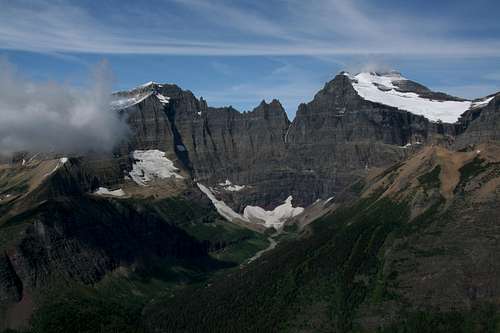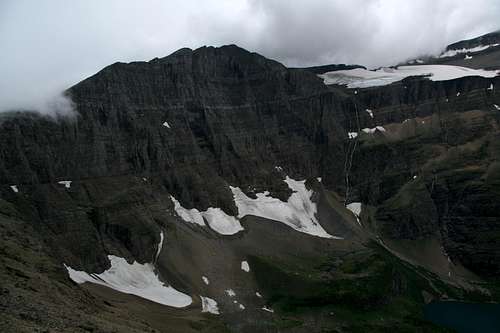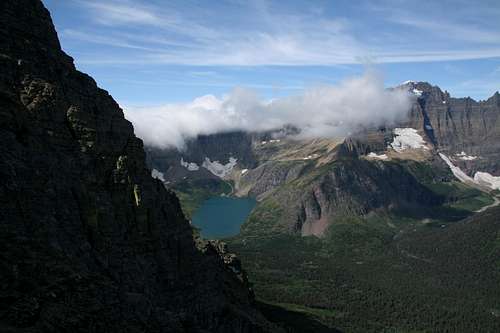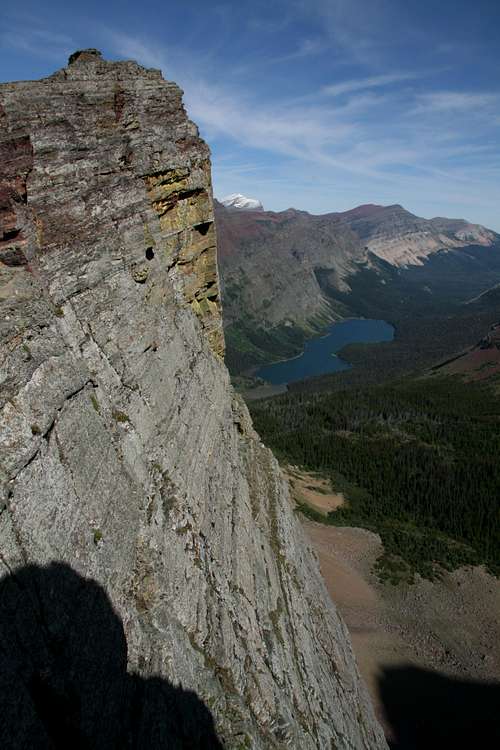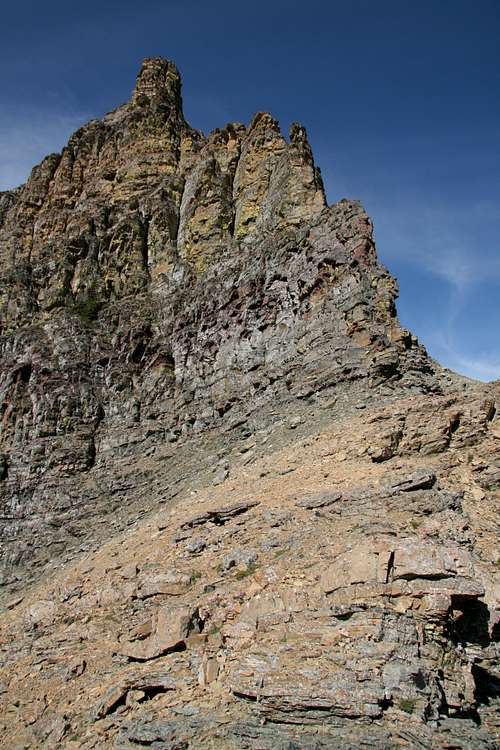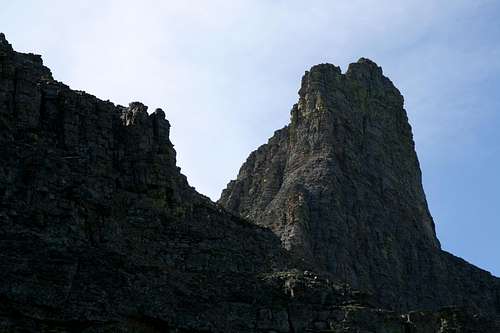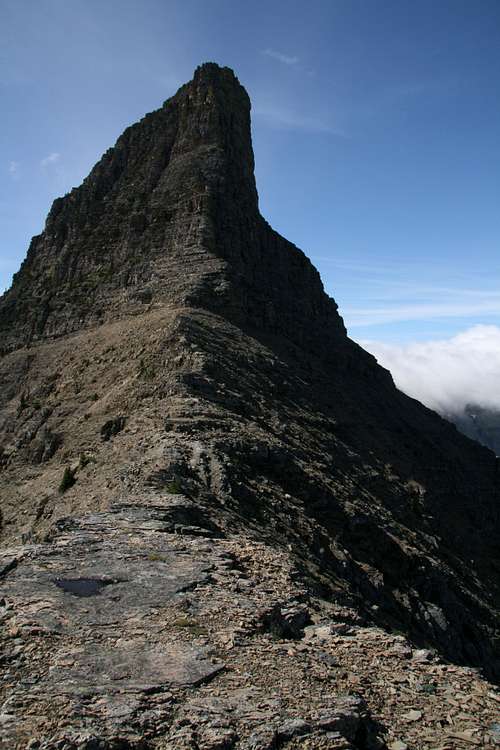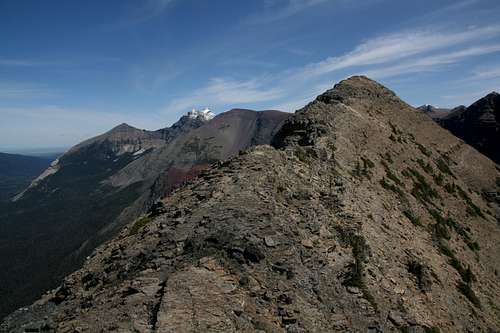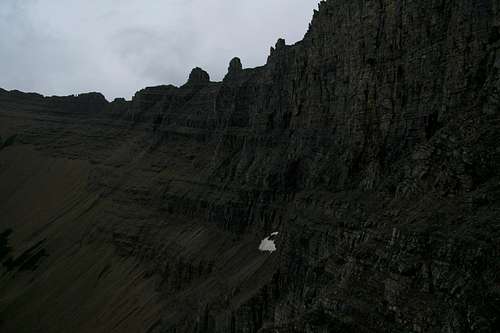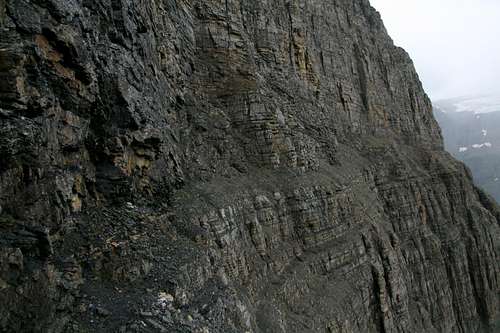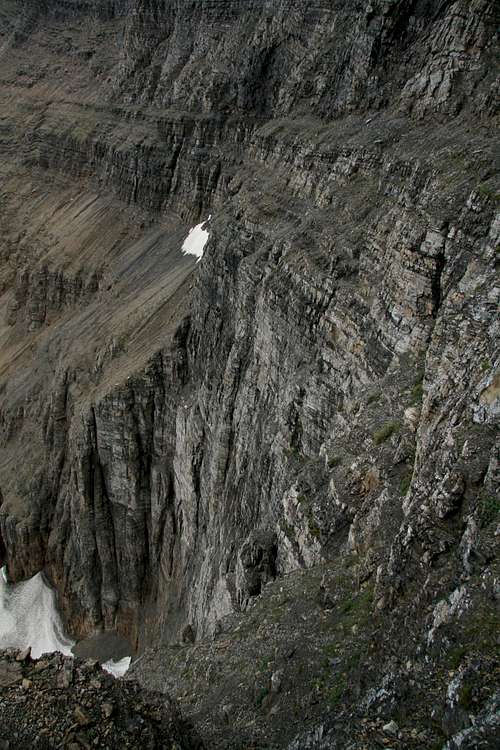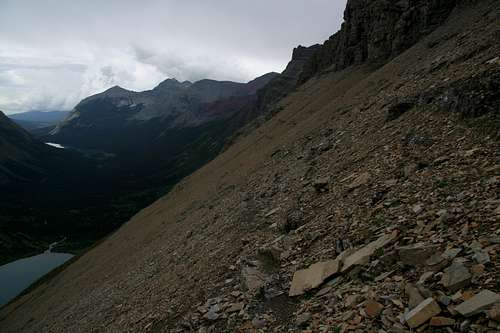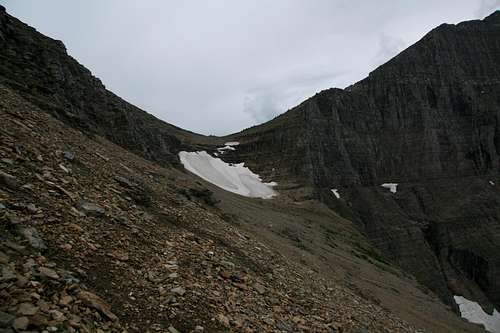-
 42684 Hits
42684 Hits
-
 96.38% Score
96.38% Score
-
 59 Votes
59 Votes
|
|
Route |
|---|---|
|
|
48.85127°N / 113.71074°W |
|
|
Mountaineering |
|
|
Summer |
|
|
Most of a day |
|
|
Class 3 |
|
|
Traverse from Ptarmigan Tunnel to Ahern Pass
Overview
The sheer, pinnacle-studded Ptarmigan Wall, with Iceberg Peak anchoring its southern end and an unnamed peak sometimes called "Ptarmigan Spire" anchoring the northern end, amazes many a visitor to Glacier National Park's Many Glacier Valley. It is easily seen from the popular and elegant Many Glacier Hotel, and it is even more amazing when seen up close from the trails to Iceberg Lake and Ptarmigan Tunnel.
Relatively few people know that on the back (west) side of this dramatic formation, there is an excellent and amazing goat trail that hugs its sheer cliffs for nearly four miles between Ptarmigan Tunnel (north end) and Ahern Pass (south end). The route is highly exposed in many places, but, discounting some snow work or Class 3 scrambling required to reach it, it is, in the end, just a hike, though not a hike to be taken lightly even by veteran mountaineers. Well, to be fair, the nature of the route makes it something more than a hike but less than a climb. Let's just call it mountaineering for lack of a better word.
Here, a "goat trail" is exactly that. It is not maintained by humans. It is created and "maintained" primarily by mountain goats but also by bighorn sheep and, to a much lesser extent, other wildlife (I have seen black bears utilizing high-elevation goat trails).
The route is worthy just on its own merits and would still be worthwhile even on an overcast day when the peaks are hidden from view, but on a nice day, the views are beyond spectacular, and they reveal parts of Glacier National Park that very few visitors ever see.
Another very nice thing about the Ptarmigan Wall goat trail is that it can be paired with one or more other routes to make an unforgettable circuit or loop. For example, one can combine this route with a climb up or down Iceberg Notch, creating a grand tour of the Ptarmigan Wall about 18 miles in length. Or, combine it with the Highline Trail via Granite Park; this will be an overnighter, and distance will vary according to how one gets to or from Granite Park.
No more-inspiring account of this spectacular journey can probably be found than the one on saintgrizzly's Glacier National Park page, where there are also some excellent photographs of the route. This page, though, aims to provide enough details to help the first-time visitor to this awesome location have a safe and enjoyable excursion. Another important purpose is to point out and clarify some problems I found with the route description provided in J. Gordon Edwards's A Climber's Guide to Glacier National Park.
Getting There
From Babb, drive west into Many Glacier Valley in Glacier National Park. Follow the road to its end at the Swiftcurrent Motor Inn and follow signs to the Iceberg/Ptarmigan trailhead. This is the way to go if climbing from Ptarmigan Tunnel or Iceberg Lake.If approaching from Granite Park, park either at Logan Pass or The Loop on Going-to-the-Sun Road, accessed from St. Mary (east) or West Glacier (west). This approach will take you to Ahern Pass, which is about 5 miles from Granite Park.
Route Description
Recommended Direction
I first followed this route south to north after climbing Iceberg Notch. Three days later, I accessed the route from the north end. Based on my experiences, I strongly recommend that any person or party following this route for the first time, even with guidebook in hand, should go from north to south. The descent from what Edwards calls the "main" goat trail to Ptarmigan Tunnel is not easy to follow if one has not been on the route before, and it is almost a given that the climber will repeatedly dead-end at unclimbable cliffs. In fact, what seems to be the most logical descent route-- following the ridge to Ptarmigan Tunnel-- leads to a hell of sheer cliffs and hundreds of feet of exposure.Also, the route trends downhill from north to south, though it is not all downhill.
Therefore, I will describe the route from north to south-- Ptarmigan Tunnel to Ahern Pass.
It is no exaggeration that this can be a dangerous route. In August 2009, an experienced hiker who had done the route before (though from north to south) died while descending from Ahern Pass in search of the goat trail. Some information can be found in this article; details are vague, but it seems as though the man fell either on the snowfield below the pass or while trying to bypass the snowfield. The man's hiking partners, who had not been on the route before, had stayed higher in search of the trail but eventually cliffed out.
This incident, sad as it is, also underscores the dangers and route-finding difficulties that can exist on this route, especially for first-time climbers and for those traveling south to north.
Route Part 1-- Approach to the Main Goat Trail
I used the Edwards guide since I was alone and climbing this route for the first time, but I found two problems, one quite significant, with his description, and my comments on those problems are in italicized paragraphs.
Hike to Ptarmigan Tunnel, which is 5.3 miles from the trailhead and a climb of 2300'. Just beyond Ptarmigan Falls, make sure you notice the trail junction and bear right, or you will be heading to Iceberg Lake.
At the south end of the tunnel (the side before you enter the tunnel if you approach it this way), scramble to the ridgetop. This is a short scramble and only marginally Class 3, but it is steep and extremely loose. It is better to scramble up eastward even though you have to turn and head west once up on top; doing this takes you away from the trail and reduces the likelihood that the scree you dislodge will crash onto the trail.
Atop the ridge, head west to the base of the sheer cliffs ahead, looking for a goat trail. Edwards cautions not to use the first goat trail, and this is good advice. This goat trail, though it is in excellent shape (at first) and very obvious, leads past a sheer north-facing cliff but soon becomes narrower and narrower and more and more exposed, ultimately ending at cliffs.
Not long after the steep (but short) descent, notes Edwards, there is a "bright red" cliff on your left that is maybe 20' high, and you must climb it to pick up another goat trail that crosses the head of a deep, wide couloir that would otherwise be nearly impossible to cross.
This is the first and more significant of the problems I found with Edwards's description. The fact is, there is a lot of red rock here, and there are a lot of cliffs. It was far from obvious what cliff he meant. What was obvious was that the trail had disappeared and that I had either missed the cliff or it just was not easy to distinguish from its neighbors. Anyway, I just decided to climb up at this point and hope for the best. After some Class 3 and 4 climbing of a good bit more than 20', I did find that next goat trail and a cairn confirming that I was on the right track. So the bottom line-- after that steep descent and traversing some very exposed ledges, when you find the goat trail petering out, climb up, angling south as much as possible, to find that next trail.
The goat trail crosses that deep, wide couloir and then crosses a series of 4 or 5 couloirs and, as Edwards calls them, their "intervening ledges and shoulders." Now, according to Edwards, the trail leaves the cliffs and reaches a steep scree slope that overlooks a "very broad basin of scree and small cliffs, above which rises a spectacular spire on the ridgetop." The goal now is to scramble up to the saddle just left (north) of that spire. And here is the second, though less significant, problem with the description.
I suppose two people can differ on what constitutes a "basin." Apparently, my concept of one is not the same as Edwards's, and perhaps his is right, considering his enviable climbing record. But what I saw was not a basin but rather a steep mountainside characterized by a mix of scree, outcrops, and small cliffs. Also, I noticed that the goat trail was again disappearing, giving way to a grass- and shrub-covered path that soon dropped any resemblance to a path at all and became lost among the cliffs just beyond this spot.
Route Part 2-- Saddle and Spire
The saddle is at about 7800' and overlooks Ptarmigan Lake, which you passed when hiking to Ptarmigan Tunnel. It took me about an hour to reach it from Ptarmigan Tunnel (it would have taken 45 minutes or less had I not stopped to check the route description several times), and I estimate the distance at around a mile (I inadvertently had the track log on my GPS device turned off). The elevation change from tunnel to saddle is about 700', but the climbing is a little more than that due to dips on the route.The spire-- Point 8447 on 1:24,000 maps-- is what Edwards calls "Ptarmigan Spire" in his book, and he identifies it as the "abrupt north end of the Ptarmigan Wall." I might argue that the north end of the Ptarmigan Wall is the great cliff just west of Ptarmigan Tunnel (especially since some maps show the wall continuing east of the tunnel), but it's not that important here.
Note if this is your first time on this route and you are traveling south to north-- To repeat what I said earlier, the descent from here to Ptarmigan Tunnel is not easy to follow if one has not been on the route before, and it is almost a given that the climber will repeatedly dead-end at unclimbable cliffs. In fact, what seems to be the most logical descent route-- following the ridge to Ptarmigan Tunnel-- leads to a hell of sheer cliffs and hundreds of feet of exposure. Hopefully, this page can be helpful in saving you from the mess I found myself in my first time on this route, as I searched (unsuccessfully) for the proper descent route in rain and fog. From the previous section, you should know to scramble down (west) from the saddle, angling slightly north, for a few hundred vertical feet until you reach the goat trail. Then follow the trail north until it begins to fade out, and downclimb around 50', again angling slightly north, to the good goat trail that takes you to the ridge right above Ptarmigan Tunnel.
Route Part 3-- Main Goat Trail to Ahern Pass
From the saddle, walk south toward the spire and look for the good goat trail that will be easy to follow from here all the way to the snowfield below Ahern Pass, 3-4 miles away. Do not go all the way to the spire itself; the goat trail departs from about the level of the saddle and goes around the right (west) side of the wall.Edwards is correct that from here on out, no more description is really needed. The goat trail is easy to follow. Views are phenomenal every step of the way. So is exposure. Although the trail is not always clinging to the edge of a cliff, it often is, and even in places where it is not, careless footing could result in an uncontrolled slide down scree that could result in a fatal spill off a cliff. There is one exceptionally spectacular section about halfway along where for several hundred yards the trail is only a few feet wide as it follows ledges and rounds shoulders on sheer cliffs, below which there is a sheer drop of hundreds of feet. It is no place to stroll along while reading your map or adjusting your camera settings.
1: Escape Option-- Around a mile along, the trail passes between two small stands of low-growing trees (easy to see from afar since everything else here is scree and cliffs). Just past (south of) this spot, you can scramble up to a notch and from there carefully descend to the Ptarmigan Trail if you have need to make an early exit from the route.
2: Below Ahern Pass, there is a snowfield you must cross/climb. This is the snowfield mentioned above in "Recommended Direction" as the likely location of the August 2009 fatality. Edwards cautions that if you get too close to the cliffs on the left (east) side, you run the risk of falling into ice caves that are below the surface of the snow near the cliffs. If you go too far from the cliffs, however, you encounter very steep snow, and a slide here could send you on a one-way trip over cliffs below the snowfield. So negotiating this snowfield can be a little like walking a tightrope.
You can avoid the snowfield by climbing the cliffs above it. Get out your Class 4 and route-finding skills for this. I used this option when going from the pass to the trail because I didn't really like the conditions I was seeing on the snowfield.



